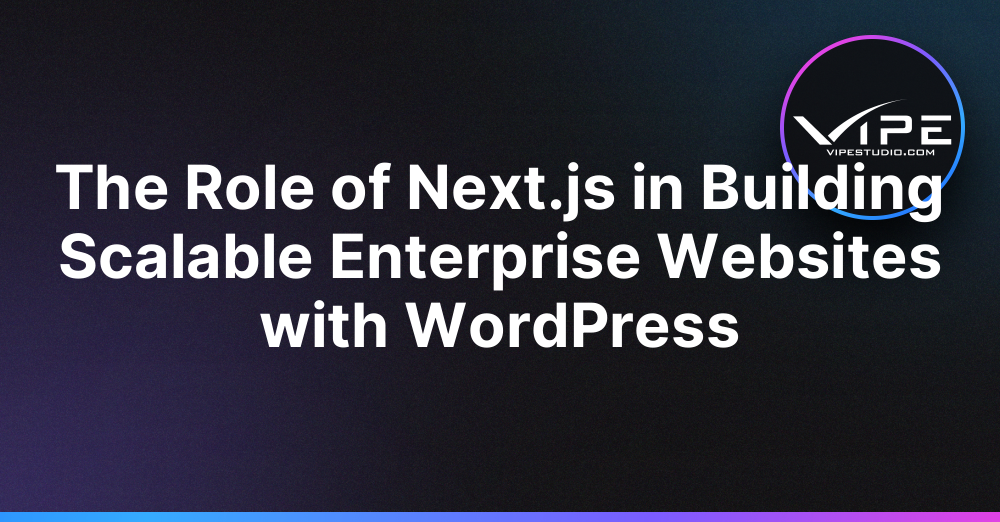09.02.2025
WordPress Development
The Role of Next.js in Building Scalable Enterprise Websites with WordPress
READING TIME: MIN
Table of Content
As enterprises look to improve their web development processes, scalability, performance, and security have become key considerations when choosing technologies. WordPress, the world’s most popular content management system (CMS), is well-known for its flexibility and ease of use, but when combined with modern front-end technologies like Next.js, it offers the best of both worlds. In this article, we’ll explore how integrating WordPress with Next.js can help businesses create scalable, fast, and secure websites tailored for the enterprise level.
What Is Next.js and Why Should Enterprises Use It?
Next.js is a powerful, React-based framework for building web applications that emphasizes performance, scalability, and ease of use. It offers features like server-side rendering (SSR), static site generation (SSG), and automatic code splitting, which enhance the user experience and improve SEO. Next.js enables developers to create high-performance, dynamic web pages that are fast, SEO-friendly, and ready for growth.
For enterprises, the key benefit of Next.js lies in its ability to create highly dynamic websites while ensuring fast load times and seamless user experiences. By combining WordPress as a content management system with Next.js as the front-end framework, enterprises can achieve unmatched flexibility, scalability, and control over their digital presence.
Benefits of Integrating WordPress with Next.js for Enterprise Websites
Integrating WordPress with Next.js offers multiple advantages, particularly for enterprises that need to deliver fast, scalable, and customizable web solutions. Let’s look at some of the most compelling benefits:
1. Lightning-Fast Performance and SEO Optimization
One of the main challenges of enterprise websites is ensuring fast performance even with large amounts of content. Next.js addresses this issue by providing features like server-side rendering and static site generation, which pre-render pages at build time for faster page load speeds. By pre-rendering pages, Next.js ensures that visitors experience near-instant load times, regardless of the size or complexity of the website.
Additionally, the performance benefits of Next.js translate into improved SEO rankings. Search engines, like Google, prioritize fast-loading websites in their search rankings, and by optimizing load times, Next.js helps enterprise websites achieve better visibility and higher rankings.
2. Scalability to Handle High Traffic Volumes
Enterprises often experience fluctuating traffic volumes, especially during peak times like product launches or seasonal sales. Next.js, when used in combination with WordPress, enables websites to handle massive traffic spikes without compromising on performance. Since Next.js generates static pages at build time and delivers them through content delivery networks (CDNs), it is highly scalable and ensures that your website can handle thousands of simultaneous visitors efficiently.
With Next.js, enterprises can easily scale their websites by adding more static pages, optimizing dynamic content, and implementing advanced caching techniques, all while maintaining a fast user experience.
3. Flexibility in Content Delivery and User Interaction
One of the major benefits of using Next.js with WordPress is the ability to have total flexibility over how content is displayed. WordPress serves as a powerful backend for managing content, while Next.js offers dynamic and flexible front-end capabilities. This decoupled architecture allows enterprises to create customized front-end experiences tailored to their specific needs.
For example, businesses can deliver content in various formats, integrate third-party APIs, or even build complex user interfaces using modern JavaScript technologies. The flexibility of Next.js allows enterprises to develop interactive and engaging websites that provide users with a dynamic and modern web experience.
4. Improved Security Through Decoupled Architecture
WordPress, while widely used, has its security risks, particularly if it’s not properly maintained. However, when WordPress is used as a headless CMS (i.e., decoupling the back-end from the front-end), security threats are minimized. Since Next.js serves as the front-end, any potential vulnerabilities that exist within WordPress are isolated, providing an additional layer of security for the website.
Moreover, Next.js supports secure HTTP headers, making it easier to implement security best practices such as Content Security Policy (CSP), secure cookies, and HTTP Strict Transport Security (HSTS). The decoupled architecture reduces the attack surface area, making enterprise websites more resistant to common web vulnerabilities.
5. Streamlined Development Process with React and WordPress
Next.js is built on top of React, one of the most popular front-end libraries for building dynamic user interfaces. Developers who are already familiar with React can take advantage of this knowledge to streamline the development process and build rich, interactive web applications. React’s component-based structure allows developers to create reusable UI components, speeding up development time and improving maintainability.
On the back-end, WordPress provides an intuitive content management system that content editors and marketers are already familiar with. By integrating WordPress with Next.js, enterprises can create a seamless workflow where developers focus on building dynamic front-end features, while content managers can easily manage and update content through the familiar WordPress interface.
How to Integrate WordPress with Next.js
Integrating WordPress with Next.js is a powerful yet straightforward process. Here’s a high-level overview of how to integrate these two technologies:
1. Set Up a Headless WordPress Installation
To begin, set up WordPress as a headless CMS. This means WordPress will act solely as the content provider through APIs (either REST or GraphQL). You’ll need to install WordPress, configure the REST API (or GraphQL plugin), and ensure that your WordPress site is accessible via these APIs for fetching data.
2. Build the Front-End Using Next.js
Once your WordPress site is set up as a headless CMS, you can begin building the front-end using Next.js. Next.js will communicate with WordPress via the API to fetch and render content. You can use Next.js’s powerful features like server-side rendering (SSR), static site generation (SSG), and API routes to create a fast, dynamic, and engaging front-end.
3. Connect WordPress with Next.js
Using the Next.js `getStaticProps` and `getServerSideProps` functions, you can pull content from WordPress using its REST API or GraphQL endpoint. This allows you to fetch posts, pages, media, and other content, and render it dynamically on the front-end. You can also add custom fields, taxonomies, and metadata to enhance the functionality of your site.
4. Optimize Performance and Scalability
Once the integration is complete, optimize performance by using caching, CDNs, and other performance-enhancing techniques. Next.js allows for the static generation of pages, which can be deployed globally via CDNs, ensuring that your website loads quickly regardless of user location.
Why Choose Vipe Studio for WordPress and Next.js Integration?
At Vipe Studio, we specialize in creating powerful, scalable websites using the latest technologies like WordPress and Next.js. Our team of experts can guide your enterprise through the process of integrating WordPress with Next.js, ensuring that your website is fast, secure, and ready for growth. Contact us today to learn more about how we can help you leverage these technologies for your business.
Conclusion: The Future of Scalable Websites with WordPress and Next.js
Integrating WordPress with Next.js offers enterprises a powerful way to create scalable, secure, and high-performance websites. By combining the flexibility of WordPress as a CMS with the modern front-end capabilities of Next.js, businesses can deliver dynamic and engaging web experiences that are both user-friendly and fast. Whether you’re building a blog, e-commerce platform, or corporate website, WordPress and Next.js provide a future-proof solution for enterprise-level digital projects.
More on The Topic
- WordPress Performance Debt Nobody Talks About
- The Admin UX That Shapes Decisions
- Scaling WordPress Without Losing Culture
- WordPress 6.9 “Gene”: What This Release Really Changes
- Managing Gutenberg Chaos at Scale
The content of this website is copyrighted and protected by Creative Commons 4.0.



